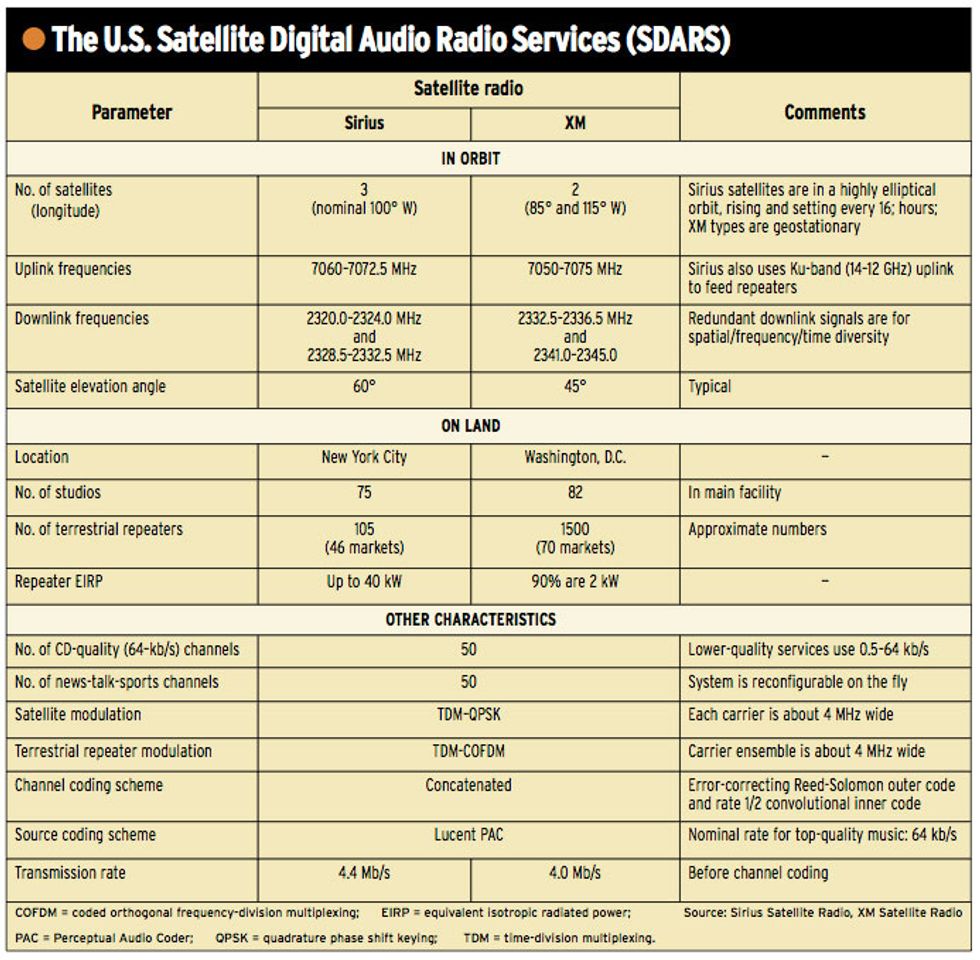Digital Radio Takes to the Road
Radio broadcasting is being remade: satellite digital radio plays for a fee to moving vehicles, and terrestrial digital radio waits in the wings
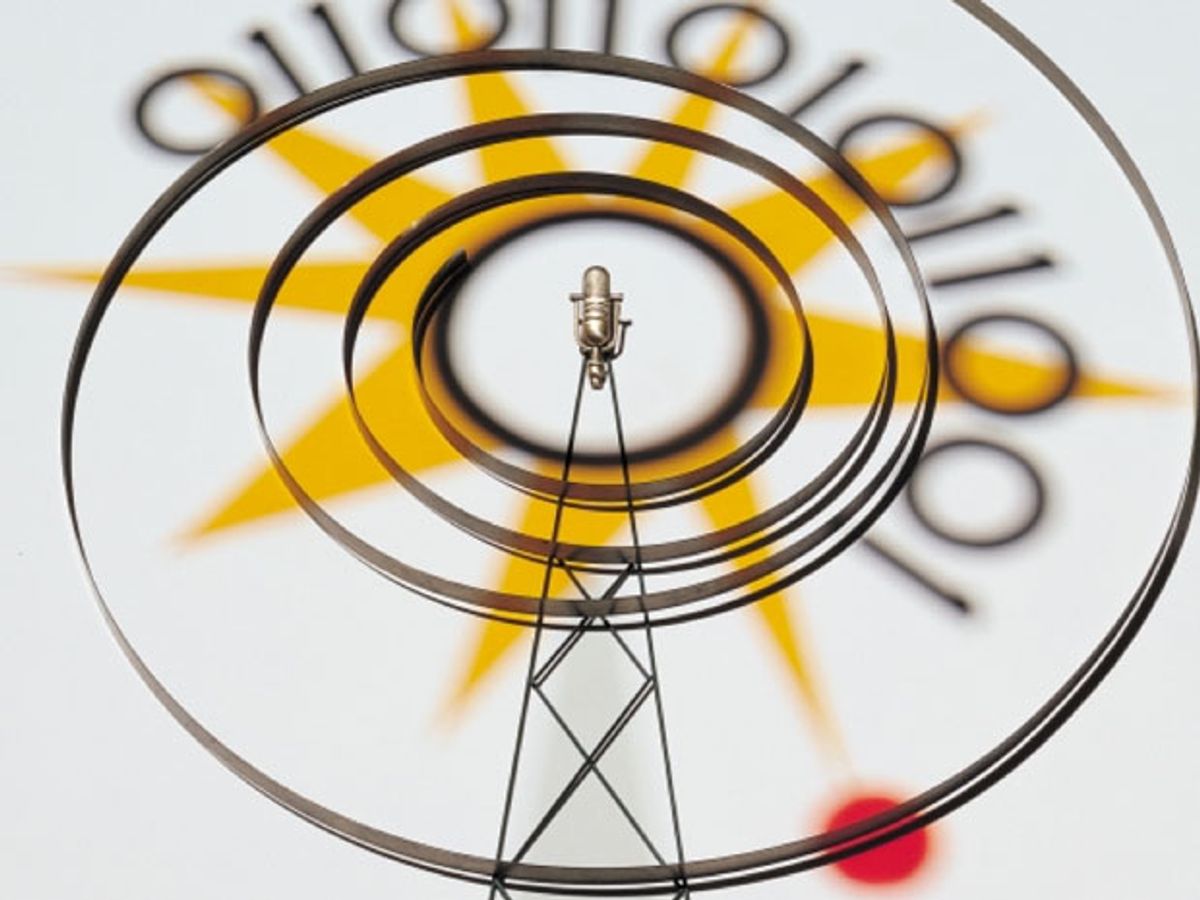
While the transition of television to a digital technology with its improved picture and sound quality has been a much publicized and controversial process, television's venerable ancestor, radio, has stayed in the background. But this year, in the United States, radio broadcasting is making its own digital leap. Two start-ups are introducing a new type of radio broadcast--subscription-based digital audio sent from satellites. With satellite digital audio radio services (SDARS), as they're called, listeners will be able to tune in to the same radio stations anywhere in the United States.
SDARS differs from so-called digital music services, in which direct broadcast satellite or cable system operators provide digitized and compressed audio over their networks, both because of its programming and because SDARS can be received in a moving car, where much of today's radio listening takes place; existing digital audio services cannot. (A different form of satellite digital radio, from WorldSpace Corp., Washington, D.C., is currently serving parts of Africa and Asia. It started service in 1999, and is less optimized for mobile use.)
Meanwhile, the free, over-the-air terrestrial broadcasters are expected to choose digital audio broadcasting technologies for both the AM and FM bands by year-end.
Why go digital
Just as was true for other media, the conversion to digital offers radio a wealth of benefits not available from current AM or FM analog systems. Radio is an audio service, so consumers naturally compare it to the most pervasive high-quality audio technology, the compact disk (CD). A good FM signal played by a high-quality, stationary receiver compares favorably to a CD's sound. But put the FM receiver in a moving vehicle (typical for radio listening), and channel imperfections experienced by FM quickly lower the sound quality. The problems include environmental noise and RF signal reflections that give rise to multipath fading--variations in RF signal level due to signal reflections. The improved robustness of digital radio promises to remedy this, delivering near-CD sound for most listening conditions.
With AM radio, the transition will be even more marked. The new digital service will offer two-channel stereo sound and greatly increased frequency response, resulting in audio quality comparable to today's analog FM.
In addition, digital will greatly enhance terrestrial radio robustness, which is the ability to withstand factors such as multipath fading, environmental noise, and impulse noise interference due to automobile ignitions or home appliances. Digital's robustness also holds up well against interference from nearby radio broadcast signals and terrain blockage for FM, as well as signal attenuation due to grounded conductive structures like reinforced-concrete highway overpasses for AM.
With most radio listening done in a moving car, the signal degradation varies constantly with time, further complicating matters. To reduce or eliminate these problems, a variety of signal-processing techniques (described below) have been incorporated into digital radio systems.
While enhanced quality and robustness and new services entice broadcasters, and should bode well for a smooth transition to digital, another, less tangible reason for making this transition involves consumer perception. Terrestrial radio is one of the few remaining analog communications services in an ever more digital world. With the advent of SDARS, radio in the United States faces a direct digital competitor, and even though SDARS will not provide a locally oriented service like traditional radio, the inevitable comparison of technologies will have "old-fashioned analog radio" coming up on the short end of the stick.
It's taken 10 long years, but finally, later this year, two U.S. SDARS systems will begin commercial operation. These two digital radio systems [see table], operated by Sirius Satellite Radio Inc., based in New York City, and XM Satellite Radio Inc., in Washington, D.C., share a number of similarities--like approximately the same number of separate radio channels--as well as some interesting differences--for example, completely different orbital configurations for their satellites. But whether the for-pay SDARS offerings will lure listeners away from the free terrestrial service is an open question.
On an advertiser-supported local station, many program formats with a limited audience could never be economically viable. SDARS' operators maintain that even narrowly specialized programming will be feasible over a service that reaches the entire nation and is supported almost entirely by subscriptions. (Sirius plans to be commercial-free; XM plans to include advertisements in its news/talk programs.)
Reach is clearly the main strength of the satellite delivery medium. Radio markets (primarily rural), now under-served by radio services with only a handful of stations, will no doubt welcome the choices offered to them by satellite radio.
The service providers themselves are optimistic. They are projecting they'll break even financially if they can each attract on the order of four million subscribers--not beyond reason in a country with a population nearing 300 million. Still, there's never been a successful subscription-based mobile broadcast service, so it's not entirely clear that the success of the cable and satellite TV industries in serving a stationary market can be repeated for radio.
Technically, the Sirius Satellite and XM Satellite systems are unique in a number of ways. This is so not just with respect to existing broadcasting systems and the many types of satellite systems (broadcast and otherwise) currently in use, but also with respect to one another. Because these systems are designed to serve primarily mobile users and are targeting a consumer market, the individual receivers need to cost less than any satellite receiver ever built. They cannot rely, for example, on high-gain antennas with costly antenna-tracking devices to keep the antenna pointed at the satellite, the setup used for other mobile satellite systems like Inmarsat, which serves maritime and other commercial markets.
Another consequence of mobile reception, for automobiles in particular, is that the satellite signal will be intermittently blocked from view by buildings or trees as the vehicle moves. The magnitude of this problem is a function of the latitude of the receiver because this establishes the elevation angle of the satellite with respect to the horizon. The farther north one proceeds, the lower in the sky the satellite appears and the more susceptible it is to being blocked from view. For both systems, the antenna on the receiver is of the low-gain, nearly omnidirectional variety, its pattern shaped like a hemisphere. So obstructions notwithstanding, the satellite will be in view of the antenna regardless of the vehicle's position.
In the XM system, two satellites in a conventional geostationary orbit, one at 85 W longitude and the other at 115 W longitude, are used. These locations afford optimum coverage of the United States. According to XM, these are the "most powerful satellites in the entertainment industry," helping to compensate for the relatively low gain of the vehicle's antenna.
Three specific techniques, each representing a different kind of redundancy known as diversity, are used by the SDARS services to enhance performance. With its two satellites transmitting essentially identical signals from two, widely spaced locations (though in different frequency bands, so they won't interfere with one another), XM has implemented spatial diversity. This arrangement reduces the probability that the satellite signal will be completely blocked from the receiver. (Sirius uses spatial diversity as well, but in a different manner.)
Under ideal circumstances, an XM receiver in a moving vehicle will "see" both satellites and be continuously receiving and processing the signals from both. Because the receiver is in motion, from time to time at least one of the satellites will be blocked by an obstacle; in this circumstance, the receiver will have to rely upon the signal from just the one (unblocked) satellite. Because the probability of signal blockage to a receiver in motion served by just a single satellite is so great, spatial diversity is a key attribute of this system. Without it, during these times of blockage the audio output of the receiver would simply disappear, a situation listeners would hardly tolerate.
The two other forms of diversity used by both systems are frequency diversity and time diversity. As mentioned for XM, each of its two satellites is transmitting the same signal but in different frequency bands. This is a form of frequency diversity and can help to combat problems associated with multipath fading, since sometimes multipath fades are frequency selective and limited to one band or the other. Finally, time diversity is implemented by introducing a time delay between the otherwise identical signals broadcast from each satellite and between the satellite and terrestrial repeater signals.
With time diversity, when a short signal blockage occurs, it will affect the two signals at different times (relative to the underlying modulation), allowing the receiver to eliminate the effect of the blockage by making use of the unblocked portions of each signal. One consequence of a time diversity system is the introduced delay. Typically on the order of 4-5 seconds, the delay makes it difficult, but not impossible, for broadcasters to use the broadcast signal as an in-studio monitor (a common practice in which the on-the-air and the control room staffs listen to the received broadcast signal to monitor its quality), or for sports fans at a sporting event to listen to a broadcast (since the audio will be lagging the action).
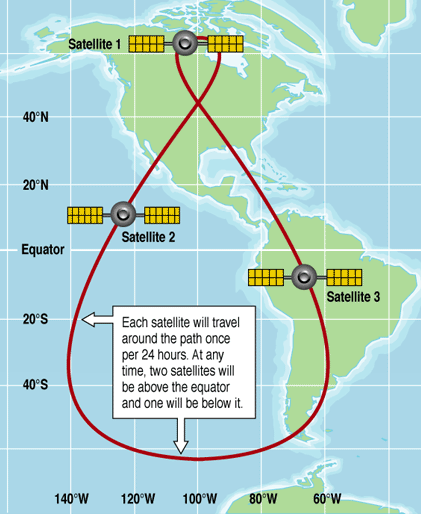
A three-satellite approach
Sirius has taken a more novel approach to spatial diversity by using three satellites in a highly elliptical orbit [see figure, "Orbiting Trio"]. In contrast, other existing broadcasting and most communications satellites are in geostationary orbits--that is, they always appear to be above the same spot on the earth. As the Sirius satellites orbit the earth, they move about a specific longitude (100) while moving across latitudes and, with respect to the northern hemisphere, rise and set approximately every 16 hours; thus two of the three satellites are visible to receivers in the United States at any given time (hence providing spatial diversity). Consequently, these satellites have an elevation angle of about 60 on average, higher than the typical 45 or so angle of the geostationary satellites used by XM, but are constantly in motion with respect to earth stations.
With this higher elevation angle, the Sirius satellites are less likely to be blocked. The constant motion of the satellites is not a problem because the receiver antennas are nearly omnidirectional and, in fact, the motion of a vehicle speeding at 100 km/hour will have a much greater impact on reception than will the apparent motion of the satellites. In the case of XM, each of the satellites will be broadcasting the same signals, but in different frequency bands [see figure, "SDARS' Broadcast Spectrum."].
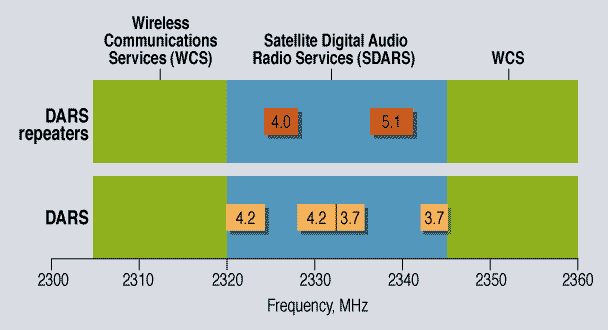
There are some operational consequences of the moving Sirius satellites. Because only two frequency bands are set aside for the satellite signals, only two of the three satellites can transmit at any given time; otherwise, two of the satellites would have to transmit in the same frequency band and would interfere with each other.
To avoid this problem, as the satellites rise and set, a "hand-off" must occur between their rising and setting--one satellite ceases transmission and the other initiates transmission. This is likely to cause a brief interruption (on the order of milliseconds) in signal reception at the receiver for the signal being handed off. As long as the signal from the third satellite is not blocked during this hand-off time, the listener will be unaware of the switch; this is likely the case since the third satellite, at the hand-off time, will be at its highest elevation angle and will therefore have its lowest probability of blockage.
Repeaters for those really hard-to-reach spots
Also affected by the motion of the Sirius satellites is the system's use of terrestrial repeaters. Both XM and Sirius will use a network of ground-based transmitters to rebroadcast the satellite signal into hard-to-reach areas such as tunnels or urban canyons, adding yet another leg to the spatial diversity of the system. These terrestrial repeaters use a modulation technique different from the one used by the satellites, being optimized for use by terrestrial transmitters--namely, coded orthogonal frequency division multiplexing, or COFDM, versus the satellites' QPSK, or quadrature phase shift keying.
For XM, since the satellites are geostationary, a high-gain (that is, a directional) antenna can be used at the repeater site to receive the incoming satellite signal. This is necessary since the rebroadcast repeater signal, which is very close in frequency to the incoming satellite signal, yet at a much greater power level, could otherwise overload the input side of the repeater.
If the Sirius repeaters were to operate in this fashion--that is, were to make use of the signal being broadcast from the satellite--then their receive antennas would have to track the satellites along their highly elliptical orbit in order to maintain isolation between transmit and receive circuits. This would be an expensive proposition. So instead, Sirius has elected to feed its repeater sites using commercially available capacity of geostationary communications satellites, which operate in a different frequency band (Ku-band), thus alleviating this problem.
Receivers for use with the SDARS service were a big hit at this year's International Consumer Electronics Show in Las Vegas in January. XM and six leading manufacturers unveiled 24 models of XM-ready radios, including a complete line of retail radios from Pioneer and Alpine and an innovative unit from Sony that can "plug and play" in car and home. In addition, Blaupunkt, Clarion, and Delphi-Delco Electronics Systems each unveiled an XM model that will be available for factory installation in new cars this year. An XM-ready car stereo will cost about US $150 more than a standard AM-FM system.
Sirius also featured radios from its partners, including Kenwood, Clarion, Alpine, Jensen, Panasonic, and Visteon. Sirius has alliances to install three-band (AM/FM/SAT) radios in Ford, Chrysler, BMW, Mercedes, Mazda, Jaguar, and Volvo vehicles, as well as in Freightliner and Sterling heavy trucks. No prices have yet been disclosed for fully capable SDARS radios, as opposed to satellite-ready radios, which are normal radios that will accommodate connections to an SDARS receiver box. But estimates are that they will start in the $300-$500 range. [For more on SDARS radios, see "Filling the Airwaves," IEEE Spectrum, p.84, July 2001.]
Terrestrial broadcasters digitize
About the same time that satellite radio broadcasters were starting their long regulatory journey to implementation, terrestrial radio broadcasters were facing up to the fact that sooner or later, they, too, must chart a digital course. In 1991, a European telecommunications consortium was finalizing a digital audio broadcasting standard, Eureka-147, describing a radically new concept for terrestrial radio broadcasting. This system utilized a new multi-carrier modulation technique--COFDM--and a 1.5-MHz-wide, multipath fading-resistant radio channel containing a group of closely spaced, orthogonal carriers that would accommodate an average of five simultaneous audio programs, as well as auxiliary data services.
For Europe, with few radio stations in the broadcasting bands and numerous government-sponsored national radio networks, this was an ideal scheme. It facilitated a network of transmitters on the ground known as a single frequency network, all broadcasting the same material on the same channel, offering virtually limitless coverage over an extended geographical region (made possible by the use of the COFDM modulation technique). A worldwide radio telecommunications conference, WARC-92, held in 1992, saw the setting aside of frequency bands in which such a system could be deployed, most notably in the L-band, 1452-1492 MHz.
Since that time, a number of (non-U.S.) domestic allocations have also been made, primarily in the VHF band (concentrated around 200 MHz), for the deployment of Eureka-147-based radio channels. These allocations were necessary because the Eureka system is a "new-band" system--it cannot be implemented in existing radio broadcasting bands because its wideband nature makes it incompatible with the much narrower AM and FM channeling schemes. Typically an AM radio channel occupies 20 kHz, and an FM one, 200 kHz.
Eureka-147 was at this time considered by the U.S. radio broadcasting industry, but early on it became apparent that it was a poor fit for the congested, commercially based U.S. radio industry. This opinion was no doubt influenced by the fact that there was no readily identifiable spectrum in which the wideband Eureka-147 signals could be placed.
A new kind of digital signal
It was in this environment that the concept of in-band/on-channel (IBOC) digital audio broadcasting was born [see figure]. The idea was to create a terrestrial broadcasting system using a new digital signal that could be transmitted in-band alongside a broadcaster's existing analog signal. In theory, this would be ideal. It would require no extra allocation of spectrum, replicate the coverage of the existing services, and allow broadcasters to remain independent from one another--no need for combining audio programs as with Eureka.
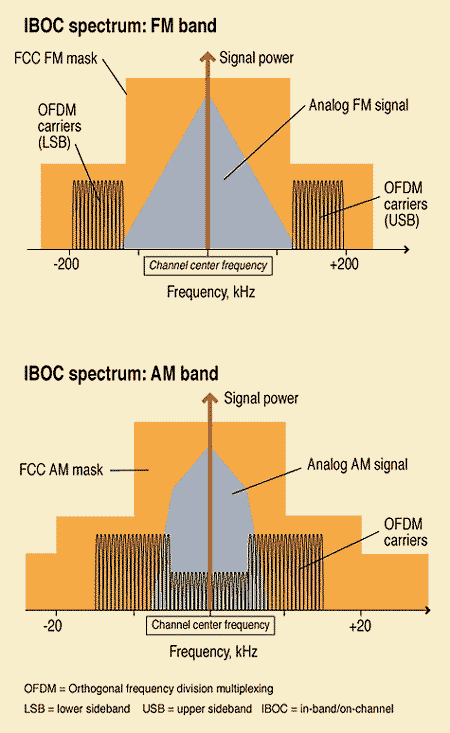
Furthermore, IBOC would provide for an ideal transition from analog to digital technology, because existing radios would be able to receive the analog portion of the signal while new receivers would use the new digital portion. Since no system like this existed, a company called USA Digital Radio (USADR), a limited partnership between CBS, Gannett, and Westinghouse Electric, was formed in 1991 and began developing IBOC technology. A competing partnership, between AT&T and Amati Communications (pioneers in the area of the now popular digital subscriber line technology for high-speed access to the Internet), was also established with the same goal.
The investigation of whether IBOC technology could offer the digital solution for U.S. broadcasters goes back to 1994. Three groups were involved: the National Association of Broadcasters (NAB), the main trade association for the free over-the-air broadcast industry in the United States; the Electronic Industries Association (EIA), a trade association for consumer electronics manufacturers; and the National Radio Systems Committee (NRSC), a technical standards-setting organization that is jointly sponsored by NAB and EIA.
A variety of technologies were tested back then, but this first generation of systems performed poorly, especially in the series of tests of system impact on the analog portion of the signal. So, going back to the drawing board, the system developers made a number of changes, such as adding time diversity (discussed earlier for SDARS) and making the IBOC digital sidebands more independent so that, if one were interfered with, good digital audio could be extracted from the one that remained.
One of the most important design decisions was to implement what is now known as blend-to-analog. In this scheme, the same audio information is transmitted on both the existing analog and new digital portions of the IBOC signal, called simulcasting, but with a time delay between them to support time diversity. The delay is removed in the receiver so that the digital and analog signals are ultimately in time alignment.
When the digital signal begins to fail, the receiver seamlessly transitions the audio heard by the listener from digital to analog. This technique resolved the hard (often referred to as cliff effect) failure mechanism typical of digital broadcasting systems, whereby the signal is perfect one moment and unintelligible the next.
Mergers result in a single developer
While these technology changes were under way, the business structure of IBOC was changing, too. After the EIA/NRSC testing was concluded, USADR and Lucent Technologies (which had been spun-off from AT&T shortly before) entered into a partnership on IBOC development, with Lucent contributing its PAC perceptual audio source coding technology to the effort.
This partnership ended in May 1998 with the formation of Lucent Digital Radio (LDR), a subsidiary of Lucent based in Warren, N.J. For the next two years, USADR and LDR would be in a competition to develop the best IBOC radio technology. Things changed again in July 2000 with the merger of these two competitors, marking the birth of the current and sole developer of IBOC technology, iBiquity Digital Corp. in Columbia, Md.
Two start-ups are introducing a new type of radio broadcast--subscription-based digital audio sent from satellites
IBiquity Digital's FM and AM IBOC systems are currently undergoing a rigorous evaluation by the NRSC's DAB (for Digital Audio Broadcasting) subcommittee. Final reports are expected to be issued this fall establishing whether these IBOC systems are "substantially improved over today's existing analog services," and whether the interference to analog from the IBOC digital sidebands is acceptable.
Laboratory testing for this evaluation is being conducted at the Advanced Television Technology Center in Alexandria, Va.; field tests are also being done at various broadcast sites across the country. Subjective evaluation of the literally thousands of audio recordings being made both of the IBOC digital audio performance, as well as of recordings of the impact of IBOC signal energy on existing analog radios, will be conducted at Dynastat in Austin, Texas.
The U.S. Federal Communications Commission (FCC), Washington, D.C., initiated a proceeding on digital audio broadcasting in November 1999, seeking to determine the best course for introduction of terrestrial DAB services in the United States. If the NRSC's report is favorable, the FCC is likely to move forward with IBOC in stages, first acknowledging it as the preferred method for instituting terrestrial DAB, followed by rule-makings on standard-setting and other issues related to the transition from analog to IBOC digital radio.
iBiquity, on the other hand, confident that its systems will be approved, has been moving rapidly forward, recently signing licensing agreements with broadcast equipment and receiver manufacturers. It has predicted that transmission equipment will be on display at the April 2002 NAB convention and that receivers will be in retail showrooms in early 2003. iBiquity plans to license its IBOC technology to manufacturers on both the transmission and reception sides of the business.
The future of radio
Clearly, the satellite SDARS and the terrestrial IBOC are poised for a battle for listener's ears in the not-too-distant future. The long-term future of radio is a bit more complicated, though.
For IBOC, iBiquity is already planning all-digital IBOC, which eliminates the analog signal altogether. This version represents the final phase in the transition from analog to digital services in the AM and FM radio broadcast bands. It would differ from the hybrid IBOC version by increasing the power in the IBOC digital sidebands and by replacing the analog signal with additional, lower-power digital sidebands. Among other things, these would support a lower-quality, but more robust, version of the main channel audio, which the system would blend to under adverse conditions (instead of to the analog signal).
The advantages of all-digital IBOC are its higher overall bit rate, better coverage, and reduced interference with adjacent channel signals. Since all-digital IBOC will produce additional interference in the analog portions of adjacent-channel hybrid IBOC signals, however, iBiquity is recommending that all-digital service not be initiated until the market penetration of IBOC receivers is at least 85 percent. Thus, a transition plan will be needed. iBiquity expects that every such receiver, starting from the first ones built, will be able to receive both hybrid and all-digital IBOC signals, so that consumers who upgrade during the hybrid service will not be left with obsolete equipment once all-digital service begins.
Both SDARS and IBOC can be expected to offer a mix of both audio and data services. Receiver manufacturers are already developing prototype receivers with color displays that support transmission of multimedia components, including images and perhaps streaming video, similar to those that have been developed for more mature digital radio services based on Eureka-147 in other countries.
Future radio services may also offer audio on demand. Digital radio receivers with memory allow for the downloading and storing of audio files that can be selected on demand, or for capturing specific news, traffic, and other programs that can be retrieved later, providing the audio equivalent of a VCR (or the newly popular hard-disk personal video recorders) for radio listeners. Command Audio, Redwood City, Calif., is pursuing this on-demand approach to digital radio, focusing on DAB systems, in particular Eureka-147 services in the UK.
Serious competition from wireless services, both terrestrial and satellite, also looms. As digital cellular phone systems expand their capabilities, and wireless Internet networks are deployed, listeners will have ever greater options in both audio entertainment and data-based services while on the go. Internet radio, however, is off to a rocky start with the recent pullback by broadcasters of their streaming signals owing to royalty disputes.
Terrestrial broadcasters will be the first to boast that their trump card in all of this maneuvering can be summed up in one word: localism. They are the service providers best positioned to offer consumers the local information and entertainment flavor they most desire, both now and in the future. If IBOC succeeds, they are confident they'll be able to meet--and beat--any digital challenge that awaits.
Tekla S. Perry, Editor
About the Author
DAVID H. LAYER (SM) is director, advanced engineering, in the science and technology department of the National Association of Broadcasters (NAB), Washington, D.C. He has been active in the radio standards-setting area, and is the primary NAB staff person on the National Radio Systems Committee's Digital Audio Broadcasting (DAB) subcommittee.
To Probe Further
The sites of the developers of the three current digital radio systems each provide technical, financial, subscription, and other information about the companies and their systems. See iBiquity Digital (https://www.ibiquity.com), Sirius Satellite Radio (https://www.siriusradio.com), and XM Satellite Radio (https://www.xmradio.com).
Radio World magazine did a special 24-page "Facility Focus" pullout on XM's studios as part of its 11 April 2001 issue.
